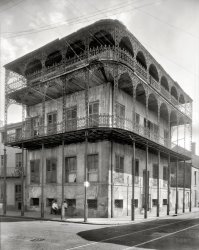
MAY CONTAIN NUTS

Search Shorpy
SHORPY ART

Framed or unframed, desk size to sofa size, printed by us in Arizona and Alabama since 2007. Explore now.
Join and Share
Ad-Free Shorpy
Shorpy is funded by you. Patreon contributors get an ad-free experience.
Learn more.

Recent comments
- Tobacco cam
- Basic fact I learned only later in life
- Put a Lid on it!
- Pinstripes in the Tower
- Sound enhancement
- 3438 in '38
- Second Career
- Their days are numbered
- Only the Sensor
- Train control mechanism
- Rarest of the Rare?? & Classy 3400 Class
- Control Mechanism
- Those standpipes
- Wrenches
- International D-40 I believe
- Job prospects
- You had me at Train
- Land of the free
- Broad-Exchange Bldg
- Parking innovation
- The old block
- "Peck turned a sweet propeller"
- National Bank Building
- Notch shot
- Straight ahead (right, left, left, right)
- Ship lifespans
- New service
- You Say Station, I Say Potato ...
- Iron Age
- Thank you, Cornelius Vanderbilt
Member Photos
The Shorpy
Printporium
Printporium
Search Shorpy
Search results -- 30 results per page
- Jean: 1937
- Washington, D.C., circa 1937. "Jean Wallace." The daughter of Henry A. Wallace, Secretary of ... Posted by Dave - 08/28/2012 - 1:03pm -
![Jean: 1937 Washington, D.C., circa 1937. "Jean Wallace." The daughter of Henry A. Wallace, Secretary of Agriculture and future Vice President, at the Wardman Park Hotel pool. Harrs & Ewing Collection glass negative. View full size.
VP KidsIt's obvious that Henry Wallace's daughter was a lot hotter than either of the two Nixon or Johnson girls.
Non-Skid SurfaceThis image nicely depicts a sensible (if no-frills) non-skid poolside surface application.
[It's certainly what caught my eye. - Dave]
Do not let your children look!Obvious propaganda for her father's socialist agenda.
Super-absorbentHer hair's dry and her lipstick's intact. She's not about to get in the pool, not with that knitted swimsuit. It looks like it can soak up fifty gallons of water.
Still with us.Jean Wallace Douglas, now 89 years old, was named one of Forbes Magazine's 400 Richest Americans in 1998.
Spy kidBefore long, Miss Wallace would graduate from Connecticut College and accept a wartime position in, of all places, the OSS, predecessor to the CIA. According to Elizabeth McIntosh's book "Sisterhood of Spies," Jean and Henry Wallace would walk to work together from their apartment at the Wardman Park, Henry eventually turning left to the White House and Jean right, to her office at the OSS's temporary quarters near the Reflecting Pool.
Wardman Park: Tower of PowerAny doubt about whether the Wardman Park apartment towers were an important axis of power in the FDR years is resolved by this excerpt from the 1940 census for that building. In successive entries are the families of Robert H. Jackson, (then the Attorney General and soon to become a legendary Supreme Court justice); Judge Fred Vinson (then on the D.C. Circuit, and the next Chief Justice of the United States); and Henry Wallace (then the Secretary of Agriculture and a few months from his selection as FDR's next running mate, and a one-term Vice President). Further down on the same page is Michigan Senator Arthur Vandenberg and his family, and on the next page, future U.S. Army General Matthew Ridgeway.
(The Gallery, D.C., Harris + Ewing, Swimming)](https://www.shorpy.com/files/images/28955a.thumbnail.jpg)
- Papered Over: 1937
- February 1937. "Negroes at Gee's Bend, Alabama. Descendants of slaves of the Pettway ... Posted by Dave - 09/09/2011 - 12:41pm -
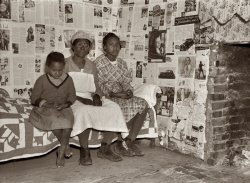
- Broke, Baby Sick: 1937
- February 1937. "Tracy (vicinity), California. U.S. Highway 99. Missouri family of five, ... Posted by Dave - 06/12/2013 - 9:19pm -
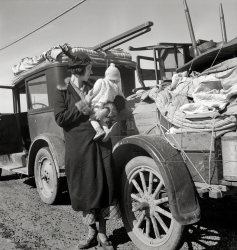
- Bachelor Miner: 1937
- March 1937. Scotts Run, West Virginia. "Employed bachelor coal miner at home in Sessa ... Posted by Dave - 03/11/2013 - 12:12pm -
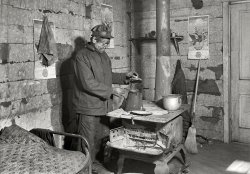
- Green Acres: 1937
- July 1937. "White sharecropper family, formerly workers in the Gastonia textile ... Posted by Dave - 11/26/2017 - 5:00pm -
![Green Acres: 1937 July 1937. "White sharecropper family, formerly workers in the Gastonia textile mills. When the mills closed down seven years ago, they came to this farm near Hartwell, Georgia." Medium format negative by Dorothea Lange. View full size.
Women had(/ve) it harderAssuming that Mr. and Mrs. Croppy are roughly the same age, or he is a bit older (as was the norm then), she aged even worse than her husband.
Good old times? Thanks, but no thanks.
Not much Green there a single weedBy the look of that family. Appears to be desperate times.
MomMom lost a finger somewhere along the line. My money would be back at the cotton mill.
Not Much Nostalgia HereWe moderns tend to forget just how poor so many people were during the Great Depression. We fixate on the "Improved Lincoln Logs" that fit so neatly on the building's façade, without noting the family's generally ragged and worn-out condition. The men/boys are barefoot, the wife/mother's shoes look like they are about worn out, and even one of the boys has a lined face -- probably a solar overdose in that age before sunscreen.
And these are an "intact" family -- not one that has broken up from the stresses imparted by poverty or suffered the death of one of the adults. They're working the land not because their ancestors did so but because their factory work evaporated. Tough times indeed.
FutureSeems to be a hard working family.
Wonder if Dad ended up with a war job; did life for the family improve in 1941/1942?
Oldest boy might have been a bit young for WWII, but he might have made Korea. The other two might also have made Korea.
Collateral DamageI've yet to see a single photograph of a Depression era migrant family that doesn't evoke in me poignancy and sadness. Only an assumption by me, of course, but I'd be willing to bet the Salt Of The Earth wife and mother pictured here will live out the rest of her days with only three fingers on her right hand due to the horrific and dangerous working conditions she encountered in the textile mills of that time period, all in the pursuit of an (un)livable wage for her family.
Barefoot familyIt's not unusual to see barefoot kids in these photos, but it's sad that even the Dad couldn't come up with a pair of shoes to have his picture taken. Both parents look prematurely aged. One can only hope that the economic boom created by WWII brought them some factory work that lifted them up economically.
August, I thinkI'm guessing it's not penury, but August. Notice that the only clothing with holes is the little boy on the right. They don't have a ton, but they bought new overalls that spring for all but the little one.
Update: regarding Naveeks' question about the haircuts, scissors have been around for a long time, and Wahl made their first home haircutting kits in 1919. Also, the culture at the time was that men got their hair cut even if they were poor--barbers have told me that their profession was one of few that did OK during the depression. Two bits per shave and a haircut for men put food on barbers' tables, really.
The Third KidAlways in the hand-me-downs!
I'm amazedthat in each of the Depression/Dust Bowl pictures that we see, the family, no matter how poor, always seems to have the children's hair trimmed and cut. Don't know how they did that.
[By Mom or Dad with a scissors, and sometimes a bowl. -tterrace]
Poor PrideMy family hails from Gaston County, where the above mentioned Gastonia - in spite of sounding like an intestinal ailment - is actually the county seat. Many of my family worked, at least briefly, in one or more of the mills that abounded in Gaston County, and gained international attention in 1929 due to the Loray Mill strike.
There is a good-natured competition among some in the area where they try to outdo one another as to who was the poorest. My stepfather, in my opinion, holds that “honor” with his haircut story. While some claim they were so poor that there mother would put a bowl on their head and then trim around it with scissors, my stepfather claims they were too poor to even own a pair of scissors. This meant they could only get haircuts in the winter, when they would wash their hair in ice-cold well water and then sit on the back porch until their hair had frozen solid. At this point his mother would place a bowl on their had and break off the now brittle hair against the bowl. He claims to have not even known any other method of hair cutting existed until he entered the Marines at age 18.
(The Gallery, Agriculture, Dorothea Lange, Kids)](https://www.shorpy.com/files/images/SHORPY-8b15407a.thumbnail.jpg)
- Migrant Mother colorized, 1937
- This is the coloration of Dorothea Lange's iconic 'Migrant Mother' photo. The stark reality of Dorothea's original photograph is actuated by the addition of color, which I think brings out detail not apparent in the black & white original. V ... Posted by Kenny - 04/11/2017 - 2:30pm -
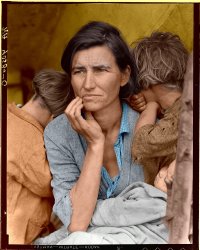
- Hung Out to Dry: 1937
- New Orleans circa 1937. "Courtyard, 620-621 Gov. Nicholls Street." Potted plants and underpants. ... Posted by Dave - 12/05/2014 - 3:59pm -
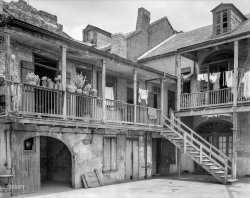
- Crossville Loafers: 1937
- 1937. "Men loafing. Crossville, Tennessee." View full size. 35mm nitrate ... Posted by Dave - 09/09/2011 - 11:22am -
![Crossville Loafers: 1937 1937. "Men loafing. Crossville, Tennessee." View full size. 35mm nitrate negative by Ben Shahn for the Farm Security Administration.
LoafersThe Rexall drugstore was the hangout in every town back then. In fact, out west they had a name for fake cowboys who never saw a cow but dressed the part: "Rexall Cowboys." They usually had a soda fountain in these stores, so the proprietor wanted people hanging around. In a small town, everyone knew everyone else, so there was no fear entering the Rexall through the crowd.
Vacation SpecialIt was a toothbrush and carrying case combo. Both only 50 cents!
Ex-LaxI like the Ex-Lax clock (or thermometer?) on the left side.
[It looks like a clock. So the sidewalk loafers had no excuse for not knowing when it was time to, um, go. - Dave]
Window ShoppingKinda hard to do any window shopping at that drug store with a group of men sitting in front of the display windows. It's almost like running the gantlet to enter the store. Wonder why the architect/builder intentionally put those ledges in front of the show windows? Surely they must have known people would promptly sit down on them.
Dr. West and his vaccination special I am guessing that Dr West went to medical school with Dr. Scholl and Dr Pepper, but what is the "Vaccination Special"?
[It's what you get before going on vacation. - Dave]](https://www.shorpy.com/files/images/8a17090u_0.thumbnail.jpg)
- Cam Ham: 1937
- November 1937. "Mrs. John Baker and baby on steps of farm home. Divide County, North ... 1940 Census data suggests the mother is Rosa (about 47 in 1937) and the child is Lois (1). Additional family members photographed in the ... Posted by Dave - 08/01/2018 - 12:02am -
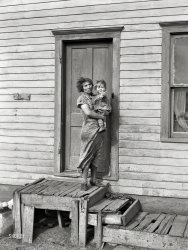
- Stoddard's Upper Range: 1937
- Savannah, Georgia, circa 1937. "Stoddard's Upper Range. Italianate structure built 1859 by John Stoddard ... Posted by Dave - 08/30/2012 - 11:05am -
![Stoddard's Upper Range: 1937 Savannah, Georgia, circa 1937. "Stoddard's Upper Range. Italianate structure built 1859 by John Stoddard on bluffs above the river, used for cotton factor's offices and warehouses." Photo by Frances Benjamin Johnston. View full size.
+73Below is the same view from July of 2010.
[Amazing! Not to mention a little spooky. - Dave]
Vics on the RiverJohn Stoddard's building was saved and is now an upscale restaurant. It also was used in the Civil War as a planning office.
MasterstrokeIn each and every one of Johnstons photos, you see the a master at work. The composition, light, shadow, and subjects are wonderful. And something else I have noticed and wonder if anyone else senses it. There is a slightly dark or macabre and foreboding undercurrent in the work. I can't quite put my finger on exactly what it is, but I feel it.
Oh, the light!Since discovering Shorpy, I've become a huge F.B.Johnston fan. Her eye for composition is excellent, her exposures are perfect, and the rendition of highlights is IMHO second to none. So delicate, so silvery.
[The detail is thanks to FBJ's use of an 8x10 view camera. As for the highlights, a lot of that is thanks to the Shadows & Highlights filter in Photoshop, which is used to adjust all of the images I post here on Shorpy. Below, a before-and-after comparison of the original archival image (grayish circles) and the Shorpy version. Click to enlarge. - Dave]
Once again, an utterly evocative image by JohnstonOf course, these buildings were never unoccupied. They were commissioned by Stoddard from the New York architect John Norris, who has forever stamped Savannah with the range of public buildings he constructed there between 1845 and 1860. He left Savannah as soon as the Lower Range and the Upper Range were finished, to return North before war broke out.
During the Civil War - umm "War Between the States, as it's called there - these buildings were occupied by Sherman's officers. Today they are full of offices, businesses, and even a fine restaurant. They are listed on the National Register.
PreservationExcept for the cars and those two exhaust fans, here is 1859 in color.
re: +73Best ever then-and-now shot. Congratulations to timeandagain photo and also to the passage of time.
PricelessIt's the 'then and now' shots alone that make Shorpy worth the price of admission...er, submission...oh, never mind. Anyway, I like them.
Factor's WalkThere's an archaeological dig going on at the time I write this, that is investigating an urban legend that the crypts on the left side of the walk (left side of this photo, but unable to be seen) were used for slave trading. However, as yet, all that has been turned up is evidence of some shops and storage. For more info, contact the Civil Rights Museum in Savannah Georgia, they are partly funding the dig.
(The Gallery, F.B. Johnston, Savannah)](https://www.shorpy.com/files/images/00867u.thumbnail.jpg)
- Guinea Pig: 1937
- July 10, 1937. "Testing cosmetics. The Department of Agriculture is making tests every ... bottles? It would be interesting to see just what's in a 1937 lab.
[They are mostly out of focus. Below: A jar of Mallinckrodt ... Posted by Dave - 08/27/2012 - 7:09pm -
![Guinea Pig: 1937 July 10, 1937. "Testing cosmetics. The Department of Agriculture is making tests every day in order to get cosmetics under the Pure Food and Drug Act. Mrs. C.W. West, seated, is helping Mrs. R. Goodman make a test on cold cream and other facial creams." Harris & Ewing Collection glass negative. View full size.
Thank GoodnessThat these were NOT tested on animals!
U.S. TowelsIf we could see all of that towel, would it say "Stolen from United States Government"?
"Tell me, what is this stuff?""It's called White Lead Paste. I assure you, it's completely safe!"
So...Any of those labels legible on the various bottles? It would be interesting to see just what's in a 1937 lab.
[They are mostly out of focus. Below: A jar of Mallinckrodt anhydrous calcium chloride. - Dave]
A Little Dab'll Do Ya"...and be sure to slather on a generous amount, so that in the event of an allergic reaction, the maximum effect is achieved..."
Welcome to my labImagine, she (or someone) once had an intimate day-to-day working knowledge of that whole rather disorderly-looking collection of variously sized bottles.
(The Gallery, D.C., Harris + Ewing, Industry & Public Works)](https://www.shorpy.com/files/images/22994a_0.thumbnail.jpg)
- Corner Store: 1937
- May 1, 1937, New York. Grocery at 1028 Third Avenue and 61st Street with Salvatore ... Posted by z396z28 - 09/15/2012 - 1:31pm -
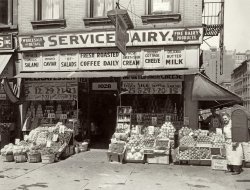
- Twig Trimmer: 1937
- August 1937. "Barbershop in village of Twig, Minnesota." Medium format nitrate ... Posted by Dave - 11/12/2015 - 9:34pm -
![Twig Trimmer: 1937 August 1937. "Barbershop in village of Twig, Minnesota." Medium format nitrate negative by Russell Lee for the Resettlement Administration. View full size.
Barber poleThere’s either the elegant rotating pole inside a glass tube or, uh, this.
[Not to mention the traditional barber building corner. -tterrace]
At Least It's HeatedExcuse me, may I use your washroom please? Looks like no water or shampoo in this place. Nor a light switch. Oh and by the way, the washroom shack is a few steps out out back, unheated.
[There is, however, free parking. - Dave]
The Old Fashioned WayJudging by the lack of electrical wires and windows (at least from this angle), it looks like this barber does things the old fashioned way: Comb and scissors by lantern light. Hope you're not too picky!
[Half of the storefront is a window! - Dave]
Floyd's Barber Shop in Mayberryis looking positively palatial compared to this.
TwigTwo Minnesota photos in as many days. But whereas Twig is way up near Duluth, Blue Earth (of Minnesota Kodachromes fame) is south of Minneapolis on Interstate 90, almost at the Iowa border.
Pole MatchingIn case a potential customer misses the barber-pole, this barber has a matching barber-corner-of-building.
One ChairLots of waiting, bet many tall tales were heard within those walls.
All GoneScissors and comb have been replaced with propane and nightcrawlers.
Out in the sticksWhen I lived in Minnesota, the joke was "Twig - oh yeah, it's out in the sticks." Looks like it still is. To add to the interesting place names, Minnesota also has a Fertile and a Climax. In journalism class, we were shown an actual headline: "Fertile Woman Dies in Climax."
S. Todd, Barber -> Twig Store Propane and nightcrawlers… I guess you'll see no cries of gentrification here.
Electrical system in a suitcase? You bet.In June, 1938, the "modern" electrical system in my Great Uncle and Aunt's, "The Walton's" style, rural general store in the Missouri Ozarks, consisted of a few light-bulbs, wire, batteries, and a hand-crank generator; all of which would fit in a suitcase. My father, a 12-year old farm-boy, powered the generator as people from all-around listened-in on a new, floor-mounted, upright electric radio to the "fight-of-the-century" between Germany's Max Schmelling and America's Joe Louis.
(The Gallery, Bicycles, Russell Lee, Small Towns)](https://www.shorpy.com/files/images/SHORPY-8b36753a1.thumbnail.jpg)
- Five-Tube Chassis: 1937
- March 1937. "Camden, New Jersey. RCA Victor. Five-tube chassis assembly line." Radio ... Posted by Dave - 05/05/2013 - 7:57am -
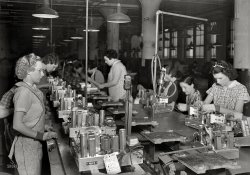
- Sun Belt: 1937
- January 1937. "Deerfield, Florida. Migrant agricultural worker from Oklahoma." Photo by ... Posted by Dave - 08/15/2014 - 3:21pm -
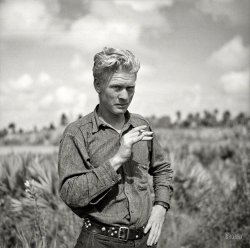
- Squatter Camp: 1937
- March 1937. "Water supply: Open settling basin from the irrigation ditch in a ... Posted by Dave - 11/29/2009 - 11:12pm -
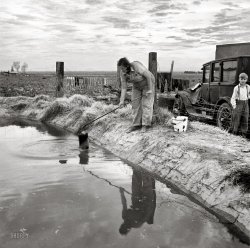
- Texaco Test Car: 1937
- June 15, 1937. Fisherman's Wharf in San Francisco. "Texaco Test Fleet auto at Joe ... he finished with a .306 BA with 46 RBI.
On June 15th 1937 the Seals were due to play hometown rivals the Mission Reds but the game ... Posted by Dave - 04/06/2015 - 11:20am -
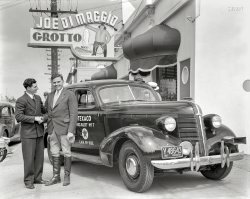
- No Money, Ten Children: 1937
- March 1937. Stalled in the Southern California desert. "No money, ten children. From ... Posted by Dave - 09/09/2011 - 12:38pm -
![No Money, Ten Children: 1937 March 1937. Stalled in the Southern California desert. "No money, ten children. From Chickasaw, Oklahoma." View full size. Medium-format nitrate negative by Dorothea Lange for the Farm Security Administration.
No Money, 10 KidsYou'd think maybe the guy with the camera could help him out.
[That would be the gal with the camera. I've wondered about that too. - Dave]
Stranded FamilyI would give anything to know what became of them.
Stranded OkieThe composition here is epic. I feel like there's an entire novel conveyed in this one image.
Compassionate, not "Immune"Ms. Lange stopped beside a car full of children that had stalled in a waterless desert. Anybody who stops for a stalled car is stopping to help in some way. At the very least she would carry the news to the next town that there were ten children and their parents stuck in the desert. It's easy to imagine that if she had any money at all to spare, she gave some to this family. (Wouldn't you?) These people were not in the safety of a migrant labor camp. They were stuck in the middle of nowhere.
It is obvious from Ms. Lange's photographs that she was not "immune to poverty." She chose to document the suffering and the humanity of people in poverty. She must have had a good rapport with her subjects, or else their faces would not be so expressive. See myhero.com (http://www.myhero.com/myhero/hero.asp?hero=d_lange ) for a short biographical essay that stresses her sensitivity and compassion. See also the Wikipedia article about her (http://en.wikipedia.org/wiki/Dorothea_Lange). "Immune to poverty" is exactly what she was not.
DorotheaLange was contracted to this work from 1935. I suppose she was quite immune to poverty by that time.
GivingYou know, in those days it wasn't easy to give money to a man like that. Most people wouldn't accept charity. It was considered an admission of failure, defeat. He might have accepted a loan. If he did, I'm willing to bet he paid it off with the first money he came by after feeding his kids.
(The Gallery, Cars, Trucks, Buses, Dorothea Lange, Great Depression, On the Road)](https://www.shorpy.com/files/images/8b31796u_1.thumbnail.jpg)
- Stuck in the Kitchen: 1937
- September 1937. "Hired girl washing dishes on the McNally farm. Kirby, Vermont." The ... Posted by Dave - 11/22/2017 - 6:26pm -
![Stuck in the Kitchen: 1937 September 1937. "Hired girl washing dishes on the McNally farm. Kirby, Vermont." The kitchen last seen here. Medium format negative by Arthur Rothstein for the Farm Security Administration. View full size.
Utility SinkThe big utility sink, covered in this picture, reminds me of "the cement sink", as my grandmother referred to it, that was in her basement.
It was originally used as the laundry sink. It was cast cement and had a divider in the middle making it a double sink. You'd wash in one section and move the clothes to the other to rinse. The one in the picture may well also be a double. There is a faint trace of a seam in the middle.
Dual use roomSince there is a razor strop, shaving mugs, a mirror and many possible medicine bottles on the shelf - could this be the only point of running water in the house?
I also found it interesting that the taps are above the counters and not over the sink.
[That's not a counter - it's a utility sink with a cover resting atop. -tterrace]
Crude but effectiveLooks like the fly paper strip(s) are a very popular gathering place on this particular day!
Not that there's anything wrong with that. As a former health inspector I can say that fly paper was a cheap, effective, and non-toxic method of pest control, approved for use in a commercial food preparation area. After a few days they do get pretty gross, though!
Multifunction KitchenIf I am looking correctly, I think I see shaving mugs and razors on the shelf. Would make the mirror have more of a reason for being there.
A Better WayIf you have cows you will have flies and we have had our share of both. Years ago we discovered a Virginia farmer who runs free range chickens behind his cows. The chickens eat the fly larva in the manure and so very few ever make it to the adult stage. We have tried this and it works great!
Very effectiveI use flypapers to this good day near my kitchen compost bin, which breeds clouds of fruit flies if I don't empty if often enough. As Rute Boye says, they are really effective for kitchen use.
Pattern Hellor pattern heaven, depending on your decorating sense. Then add two more patterns for the dress and apron, and the eyes reel.
Anonymous womanLet's hope this unknown woman, whose face we don't see, got some decent work on the home front during WWII. Being a hired girl on a farm seems like a sad and isolated life. Even the WPA photographer declined to name her.
Razor stropI wonder how many recognize that thing hanging in the doorway all the way to the right is a razor strop?
Primping in the kitchenAlong with the shaving mugs and mirror, notice the old fashioned curling iron almost directly under the wall clock, I have one exactly like this in my collection and it is not electric, but one that was manually warmed.
(The Gallery, Arthur Rothstein, Kitchens etc.)](https://www.shorpy.com/files/images/SHORPY-8b16736a.thumbnail.jpg)
- Family Trip: 1937
- May 1937. "Migratory family traveling across the desert in search of work in cotton ... that there would have been cotton in the desert in 1937, but what do I know?
There are enough people in that family that ... Posted by Dave - 06/29/2013 - 11:22am -
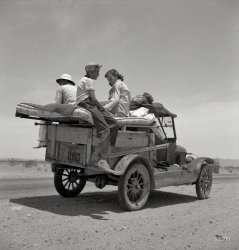
- Tommies Too: 1937
- Savannah, Georgia, circa 1937. "38 Price Street." Beer sign by Acme Radio & Neon. Our second look at ... Posted by Dave - 08/30/2012 - 11:03am -
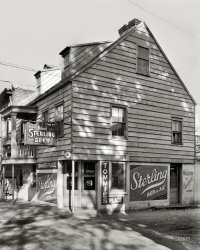
- Beer Here: 1937
- Sept. 1937. "Barber shop and pool hall. Berwyn, Maryland." Between rounds, you can ... Posted by Dave - 03/25/2013 - 2:03pm -
![Beer Here: 1937 Sept. 1937. "Barber shop and pool hall. Berwyn, Maryland." Between rounds, you can get a haircut. Medium-format negative by John Vachon. View full size.
Clever sloganFree State was located on Baltimore's Hillen Street, I believe; the site is now occupied by a Baltimore fire house. Their slogan was one of the neatest going: "Your Thirst Choice". Unfortunately for them, their beer WASN'T Baltimore's first choice [or second or fourth...].
Shaefer took over Gunther's and dropped the name, dropped the recipe and thought Baltimoreans would flock to Shaefer. It didn't happen.
Globe Brewing had a lineage dating back to the late 18th Century.
All gone todayArrow Beer was a brand of Baltimore's Globe Brewing and lasted until 1963. Gunther Beer merged with Schaefer around the same time, with the Baltimore facility lasting about another decade. Free State closed in 1952; there is now a popular Kansas microbrewery of the same name but I don't believe they are related.
I Wondered What The Good Head Was OnNow we know.
I only need a shave.Make mine a shorty and a shot.
Handled CorrectlyYou could stay there forever. No need to go home.
Trolley Tripper?With one or two transfers John Vachon could have easily traveled from his Rosslyn, VA photo locations to this one. Most of Berwyn's business district was within a block or so of the trolley line. In fact, I have a dim memory of my dad and I visiting a barber shop there in the 50's that sat right next to the track.
Old Hopfheiser (Hop-Hi-Zer)Hopfheiser Beer was contract brewed for a distributor in the Washington, DC area by the Globe Brewing Co.
The beers may be gone, butThe building lives on at 5000, 5002 and 5004 Berwyn Road, Berwyn Heights. Berwyn Road is of of US Route 1 just north of the University of Maryland.
Short walk to trolleyThe trolley ran on what is now the College Park Trolley Trail that is approximately 50 yards away. The correct current address is 5002 and 5004. 5000 is corner building not pictured in Vachon image.
Growing up a GuntherGrowing up in Baltimore with the last name of Gunther could be hazardous. I was always subject to any juvenile humor that would turn around a jingle to my disadvantage.
The ad in the comment below was before my time thankfully but I still remember being playfully taunted by my friends whenever a new campaign would roll out. My bearing the brunt of the jibes was finally paid off when in 1954 the Baltimore Orioles came to the American League and Gunther became their TV sponsors and out in left field was a big scoreboard with my last name along the bottom.
(The Gallery, Eateries & Bars, John Vachon)](https://www.shorpy.com/files/images/SHORPY_8b31483a.thumbnail.jpg)
- Family Truckster: 1937
- May 1937. "One of three related Oklahoma drought refugee families on the highway ... Posted by Dave - 06/24/2014 - 9:11am -
![Family Truckster: 1937 May 1937. "One of three related Oklahoma drought refugee families on the highway near Lordsburg, New Mexico, going to Roswell to chop cotton." Photo by Dorothea Lange for the Resettlement Administration. View full size.
Homestead HeadgearTwo things jumped right out at me. The Texas license plate with the word "Farm" on it. Might it be that the state charged the farmer or the farm workers less than a regular tag or that juveniles could drive them on the property?
The other is that ten-gallon hat. I never realized that people, other than the actors in the 1930s cowboy films, wore them.
Hat's OkayBoys wore all kinds of interesting hats in the 1930s. Some of the male characters in the OUR GANG films wore leather aviator helmets with goggles, cowboy hats and beanies, kind of like a baseball cap without a bill. But the migrant farm workers in the picture really needed their big-brimmed hats for protection from the blazing sunshine of the fields.
That Hoot Gibson lookFor a true cowperson, the hat is always the last thing to go during hard times.
All God's children got shoesWell, not all of them. The people in this picture resemble the parched, weather-beaten landscape shown in the background, stripped and hanging on for dear life, barely alive, struggling for a shred of hope that things will get better. These 1930's dust bowl photos do remind us not to feel sorry for ourselves. Even the poorest among us today are living a luxurious existence compared to these down-trodden families.
Texas Farm PlatesIntroduced in 1934 with discount registration, still used today. Vehicle is supposed to be used off the farm only for "farm business." When I was in the Air Force in Texas in the 1960s many of the civil servants had farm plates on their pickups and a permanent hay bale or such in the back to prove "farm business" to any overeager State Trooper. This poor family's "farm business" has taken them a looong way from home.
In perspectiveThis picture has really touched me. Think this poor family has run out of gas - in more ways than one. I'd love to have it on my wall as a reminder to keep everything in perspective.
StetsonThe hat reminds me of Elmer Keith who wore the same style Stetson for most of his life. The second thing I noticed is the boy in bare feet and robe.
I am having trouble matching up the reflection in the window with the rest of the photo though.
[It's not a reflection; we're looking through the windshield to the back of the truck. -tterrace]
Movie TriviaIsn't Lordsburg the town that The Ringo Kid was heading for in the movie 'Stagecoach'?
(The Gallery, Cars, Trucks, Buses, Dorothea Lange, Dust Bowl, Great Depression)](https://www.shorpy.com/files/images/SHORPY-8b31923u.thumbnail.jpg)
- The Tree of Libity: 1937
- June 1937. "Mississippi grocery store." Another of Dorothea Lange's quirky-sign ... Posted by Dave - 03/22/2014 - 9:16pm -
![The Tree of Libity: 1937 June 1937. "Mississippi grocery store." Another of Dorothea Lange's quirky-sign photos. Resettlement Administration nitrate negative. View full size.
YARD. BIRDS.YARD.
BIRDS.
BY.
THE
STEPS.
PresumablyM. ARK was the gifted painter of this sign?
Belly LaughJust a quick thank you for the picture and the hilarious comments. Haven't had a good laugh in a long time. What a bunch on this one!
That signwould sell handsomely today at auction, listed as a "Period Piece".
[LOL. -Dave]
Perhaps M.ARKis "The Man Who Shot Libity Valance"?
Not Built To LastI do a lot of work researching historic sites, and photos like this make me understand how entire communities of wooden structures can disappear seemingly without a trace.
Check out the store's "foundation," which appears to consist of floor joists set on top of rough hewn sections of tree trunks. A few decades of dry rot or termites, followed by a quick shove by a tractor, and a structure like this would be a memory. Only archeologists would be able to find evidence of its existence.
Give me libitybut don't give me debt.
And Justis For AllIs it possible that the grocer's name was Libity?
Easy access to the wine cellar.
The artist known as M. ARK?Possibly taking a break (face down) in the doorway?
(The Gallery, Dorothea Lange, Stores & Markets)](https://www.shorpy.com/files/images/SHORPY_8b32152u.thumbnail.jpg)
- Hard Times: 1937
- March 1937. Scott's Run, West Virginia. "Johnson family -- father unemployed." ... full size.
Atomic Heat Nuclear powered stoves in 1937. Who'd a thunk it?
I know where that stove ended up 5 years later ... Posted by Dave - 03/26/2013 - 9:15am -
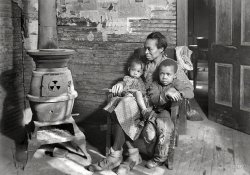
- Washington Gas Light: 1937
- Washington, D.C., 1937. "Washington Gas Light Co., 10th Street N.W." Current tenant: The FBI. ... At the top of my first hot rod wish list was a 1937 Ford coupe. That was in '53 and I still haven't found one.
Dic A Doo ... Posted by Dave - 12/28/2015 - 2:10pm -
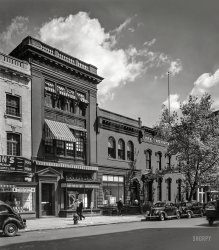
- Green Acres: 1937
- September 1937. "Cabin of Steve Flanders, cut-over farmer near Northome, Koochiching ... Posted by Dave - 02/22/2018 - 12:57pm -
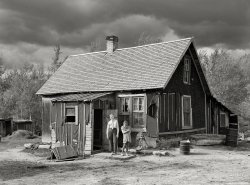
- Bachelor Shacks: 1937
- March 1937. Paterson, New Jersey. "Textiles. Bachelor shacks in outskirts of ... Posted by Dave - 03/24/2013 - 7:31am -
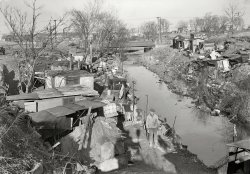
- Royal Castle: 1937
- New Orleans circa 1937. "1300 Royal Street." Longtime residence of A. Fern. 8x10 inch acetate ... Posted by Dave - 05/22/2014 - 3:42pm -
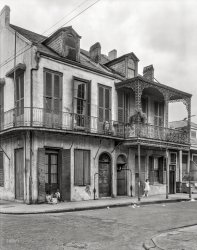
- Filigree: 1937
- New Orleans, 1937. "Le Pretre Mansion, 716 Dauphine Street, built 1835-6. Joseph Saba ... Posted by Dave - 07/19/2012 - 4:36pm -
